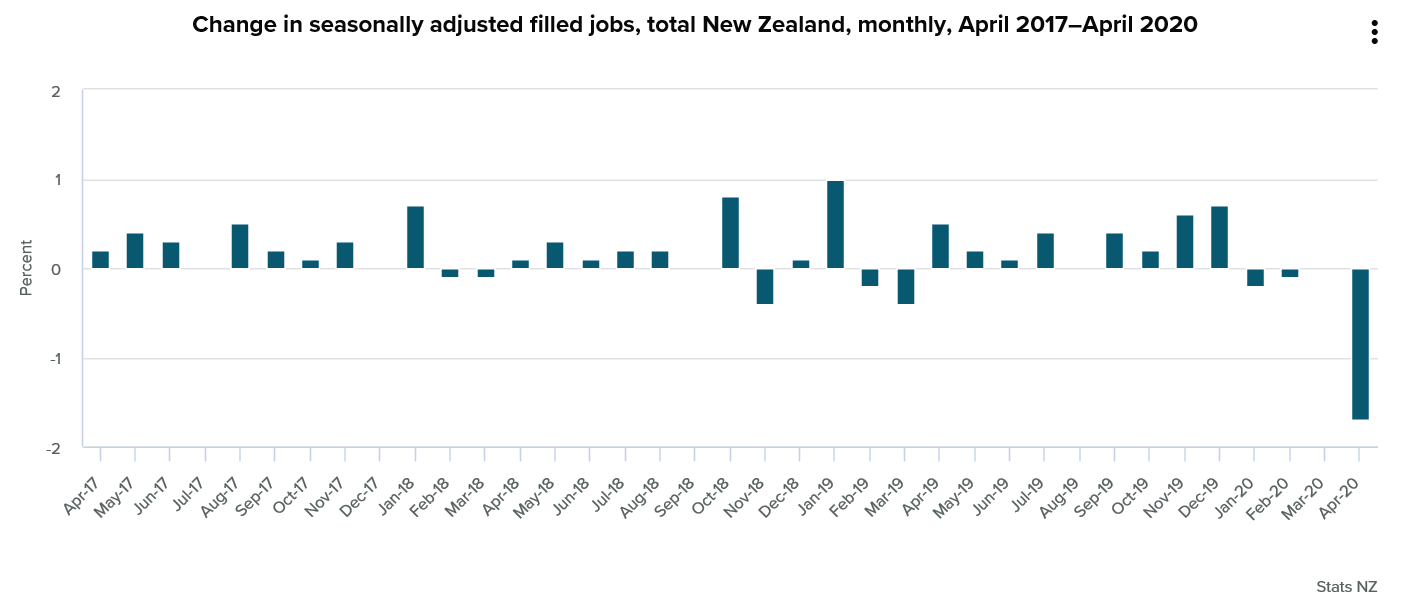
Statistics New Zealand says job numbers fell by 37,500 in April as the COVID-19 lockdown took its toll. That's the biggest drop both by numbers and in percentage terms since Stats NZ's filled jobs series began in 1999.
Here's Stats NZ's release.
Job numbers fall sharply in April
Job numbers fell by a record 37,500 in April 2020, as COVID-19 effects and restricted trading began to impact on the economy, Stats NZ said today.
In seasonally adjusted terms, total filled jobs fell 1.7 percent in April 2020 compared with March 2020, when it was flat.
April’s fall is the largest in percentage terms and by number since the filled jobs series began more than 20 years ago, in 1999.
“With the country in lockdown throughout most of April 2020, the impact of COVID-19 is now being seen in falling job numbers,” economic statistics manager Sue Chapman said.
“Non-essential businesses closed during the lockdown, though some people were able to work from home.”
Stats NZ calculates filled jobs by averaging weekly jobs paid during the month, based on tax data. Filled jobs include jobs paid by employers who are being subsidised by the COVID-19 wage subsidy scheme.
“While a fall in filled jobs does not necessarily mean employment has ceased in all cases, we saw a rise of over 30,000 people claiming the government’s Jobseeker Support benefit in April,” Ms Chapman said.
See COVID-19 data portal for data on the changing state of aspects of the economy since the COVID-19 outbreak.
By broad industry, filled jobs in the primary industries fell 4.3 percent (4,480 jobs). Filled jobs in the goods-producing industries fell 1.0 percent (4,153 jobs) and in the service industries they fell 1.7 percent (29,317 jobs).
At a lower industry level, actual (not seasonally adjusted) filled jobs fell in almost every industry between March 2020 and April 2020. The largest falls were in agriculture, forestry, and fishing (down 8,488 jobs), accommodation and food services (down 6,251 jobs), and manufacturing (down 3,797 jobs).
At a regional level, actual (not seasonally adjusted) filled jobs fell in all regions between March 2020 and April 2020.
See our dynamic map monthly changes in filled job numbers by region for more information.
Gross earnings
The amount of gross earnings paid to employees in April 2020 was $11.1 billion. This compares with $10.8 billion paid in April 2019. Gross earnings often move up and down every month due to payday timings.
“These gross earnings include earnings paid by employers subsidised by the COVID-19 wage subsidy scheme,” Ms Chapman said.Additional data released
Stats NZ has released the following additional data to help better inform on the impacts of COVID-19 on jobs and earnings in the economy.
- Filled jobs data for all lower-level industries (Australian and New Zealand Standard Industrial Classification (ANZSIC) 2006 divisional levels). Previously Stats NZ released some of the lower-level industries. This is actual data only, from May 2019 to April 2020. See Employment indicators: April 2020 and access the filled jobs CSV file under 'Download data'.
- Filled jobs data by region. This is actual data only, from May 2019 to April 2020. See Employment indicators: April 2020 and access the regional filled jobs CSV file under 'Download data'.
COVID-19 data portal includes employment indicators data as well as other labour market indicators including jobseeker support benefits and wage subsidy assistance.
And here's Westpac economist Michael Gordon's comments.
Stats NZ’s monthly employment indicator is normally a low-profile release, but it is the first official data we have on employment during the Covid-19 lockdown. This indicator is drawn from tax data, giving it a high level of coverage. A similar measure has been developed in Australia, though that one is published weekly rather than monthly.
Filled jobs fell by 37,500 in April, a 1.7% drop compared to March. That’s similar to the increase of about 30,000 in the number of people receiving the Jobseeker Support benefit over the month.
The impact of the lockdown on jobs was undoubtedly blunted by the wage subsidy scheme, which was announced in March and paid out rapidly as a lump sum to eligible businesses. The full impact of Covid-19 on jobs is likely to take several months to play out, as the expiry of the wage subsidy weighs up against the reopening of businesses as we move out of lockdown.
Employee earnings saw a bigger decline, down by an estimated 8% in seasonally adjusted terms. The difference between the two measures may reflect workers who kept their jobs but faced pay cuts or reduced hours. That said, the earnings measure is typically much more volatile than the jobs measure, so we can only draw tentative conclusions from this.
14 Comments
Let's list the employment-related numbers that Stats does not (and cannot objectively) count:
- Sole traders throwing in the towel and taking early retirement
- SME's deciding that now is Not a good time to hire, but that shiny Robot, financed at 0.99%, looks....Enticing
- Already-retired casual/cashie workers actually - er - Retiring
- New business propositions, which passed the feasibility test pre-WuHuFlu, reassessing and deciding against progressing
- Larger businesses fracturing into several smaller, shedding layers of middle management and overhead. Total employment might stay the same overall, but average salaries will be much less....
Commenters can doubtless think of more uncountable damage.....
Who is working for what portion of their previous wages is a big one.
also underutilization where people are working 3 or 4 day weeks at the moment
Both of those should be measurable, though.
We tend to only measure what we are interested in. Or if we do measure something embarrassing that's usually buried.
Another split between labour and nz first
"My overarching feeling is that they should go home. And if it's possible for us to assist them to go home then that to me is a very Christian thing to do.
"Secondly, the difficulty that I have, on behalf of NZ First, with opening the border for visa-holding migrants to come back to New Zealand is I don't see why I should agree to that if we've got legions of Kiwis who have now been dislocated from the labour market and are themselves looking for jobs."
https://www.newsroom.co.nz/2020/05/26/1203591/going-christian-on-migrat…
We have a problem with immigrant agricultural/rural workers because the majority of out-of-work people will not be able to move to take up new long-term jobs. They will have unavoidable family and financial commitments (mortgages, long term rentals) in the towns and cities they live in (NZ is nearly 90% urban) that they cannot realistically leave, and it can easily cost $10k to move. Unlike NZ before the 1980s almost all couples these days are two income, kids in schools etc, it's not like they can just uproot to chase a lowish paid job at short notice.
Not at short notice but in the medium term it's possible and probable. Why stay in Auckland paying extremely high housing costs if you don't have the higher paying job that justifies those housing costs?
People are mobile. In the last census, 34% of people lived somewhere other than the home they lived in on census night 2018 in 2017 and 60% lived somewhere other than the home they lived in on census night 2018 in 2013. People move quickly during normal economic conditions, how much more quickly do they move when economic forces push them to?
Using the StatsNZ estimate of the labour force size of 2.6m that's a 1.4 percent increase in unemployment for April and its getting worse fast (looking at stuff's estimate upto 90,000 affected) . Applying these numbers to the RBNZ scenarios its only needs 240k (13.7% - 4.2% jan unemployment) total before we reach the stress scenario and less than 110k more before its defiantly all over for the banks.
I think its time to plan a way to get your money out of the bank, keep your TD short.
Well, it seems that the RBNZ itself is inviting a run on the banks with ever lower interest rates. It makes you wonder who will be left to finance the NZ housing Ponzi scheme.
Gareth Vaughan's interview title yesterday:"RBNZ Deputy Governor Geoff Bascand says deposit rates could drop to zero and some savers might want to put their money to work elsewhere"
I don't think they care if put your deposit under the mattress in the modern world with overseas funding. It's only a little worse than in the bank as a deposit. He's trying to get those of us who could to (borrow and) spend to help keep things afloat for the banks during the crisis.
How many people have taken pay cut should also be accounted along with business loss.
"The amount of gross earnings paid to employees in April 2020 was $11.1 billion. This compares with $10.8 billion paid in April 2019"
Again, I was ridiculed for saying losing your job is not the same as losing your income…
Is there a way to quantify income loss through all job losses vs total of all types of subsidies paid by the government. I would really, really like to know this data
I work for Shopless and we have had an increase in the number of jobs listed on our platform: https://www.shopless.co.nz/browse/jobs


We welcome your comments below. If you are not already registered, please register to comment
Remember we welcome robust, respectful and insightful debate. We don't welcome abusive or defamatory comments and will de-register those repeatedly making such comments. Our current comment policy is here.